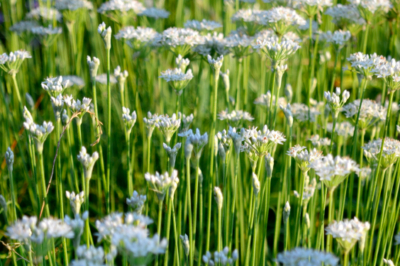Chive garlic, often also called Allium tuberosum or Chinese chives, belongs to the allium family just like chives, garlic or onions. In terms of botany and appearance, it is quite similar to conventional chives (Allium schoenoprasum), but unlike the latter, it has a distinct garlic flavor. Also, the leaves grow taller, up to 80 centimeters, and are also wider.

Contents
Location and substrate
Chives need a loose and nutrient-rich soil, which should also be rather moist. You can loosen loamy soil with humus and sand, because the plant does not tolerate waterlogging. Otherwise, he feels very comfortable in a sunny to semi-shady place – only full sun as well as shade should be avoided.
Watering and fertilizing
Always keep the plant moist, but avoid waterlogging. Especially in summer dry periods, even specimens planted out in the garden should be watered regularly. For fertilization, a biological vegetable fertilizer is recommended, which can be added to the watering every four weeks. In addition, provide the plant with mature compost in the spring. In winter, on the contrary, do not fertilize.
Harvesting and wintering
Cut garlic is a perennial plant whose above-ground parts die back completely during the cold season. However, it quickly sprouts again the following spring. If you want to harvest all year round, you should cultivate chive garlic in a pot and overwinter it at about 12 to 18 °C in a bright place. Planted out chive garlic can be harvested from June to October. Cut the stalks a few inches above the ground and, if possible, do not harvest the entire plant. As with chives, the flowers and buds can be used in cooking.
Good neighbors / bad neighbors
Similar to chives, cut garlic harmonizes very well with cucumbers, tomatoes, strawberries, carrots and nasturtiums. A mixed culture with other leeks (especially leeks) as well as cabbage, beans and peas should be avoided.
Tips & tricks
The easiest way to propagate cut garlic is by division. For the purpose of rejuvenation, this measure should be carried out about every three years. The division is done either in early spring or in late autumn.

